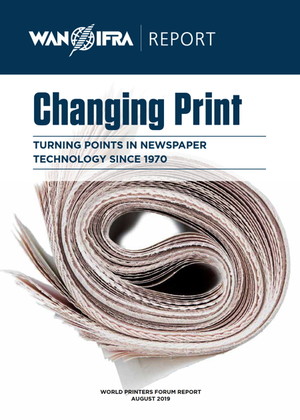Changing Print – Turning Points in Newspaper Technology Since 1970
Changing Print – Turning Points in Newspaper Technology Since 1970

Price
- For non-members: 150 EUR
- For WAN-IFRA members: Free
Download
Employees of WAN-IFRA member organizations can download the report free of charge here, as a membership benefit:
(Note: You do not need your log-in – just your e-mail address.)
Attention non-members: Click here to purchase the report.
Not yet a member? Learn more about WAN-IFRA membership.
Summary
The foreword by Kasturi Balaji, former Director, The Hindu Group, India, to this World Printers Forum Report:
The past five decades – 1970 to date – have witnessed momentous changes in the technology used to produce newspapers. This report is a compilation of articles on some of the most important changes written by people of eminence in their respective fields of expertise. The idea for such a compilation was triggered when I was reading "The Matter of the Heart – A History of the Heart in Eleven Operations" by Thomas Morris. The book is essentially, as the title suggests, a tracing of the journeys of the major heart surgeries. It struck me that, in a similar way, it was necessary to record and highlight the major developments that changed the direction of newspaper printing in the areas of quality, speed, efficiency and business potential. Over the years newspaper production technology had of course not remained static. But the period from the 1970s has seen more changes and at a rate that could not have been anticipated in the 1940s and 1950s.
One of those who was remarkably prescient was Theodor Oltheten, the director general of the Dutch government printer in The Hague. Speaking on the future of the newspaper at the INCA (International Newspaper Colour Association, the forerunner of IFRA) Conference in 1969, he made the following points:
■ "Research in newspaper technology requires an interdisciplinary, comprehensive approach.
■ Newspapers will survive the attack of new media if they focus on their own strengths instead of competing with the speed of the new media. In this context, the behaviour of the readers (trend research) must be thoroughly analysed.
■ The line between editorial work and the technical operation of typesetting will become increasingly blurred in the future.
■ To ensure the stability and success of the newspaper in the future, central information databases must be established in the publishing houses, which all departments can access.
■ Despite all prophecies of doom, colour is going to trigger a snowball effect.
■ Inserts are gaining commercial importance for newspapers.
■ The introduction of offset printing will pick up pace even at large newspapers.
■ Due to population trends in population centres current newspaper distribution will become inadequate and lead to a decentralisation of newspaper operations."
In August 2017, I placed the idea of producing a special report on the technological turning points before Manfred Werfel, Deputy CEO of WAN-IFRA. By early 2018 Manfred had obtained the green signal from the World Printers Forum Board and its Chairman Rick Stunt to publish it as a WPF Report.
Our next task was to look more closely at the content and the possible contributors. The expert group of veterans, near-veterans and professionals still in industry whom we got in touch with responded most enthusiastically and promptly to our "call for help." This was very evident from the participation in the first meetings of the group members in Frankfurt and London in June/July 2018. In the meantime a collaborative digital workspace had been created and relevant reference material from the archives had been uploaded.
In the concluding paragraph of the introduction to his book, Thomas Morris writes, "This is not a comprehensive history of the subject, and I have had to be highly selective in which operations and individuals to include; many other important contributions were made which, with regret, I was unable to acknowledge. At times progress was driven by competitive individuals, at others it was a team effort; but what they achieved was miraculous ..."
Input from readers sought
One can say that these words apply in equal measure to this report, which does not cover the game-changers in all areas of newspaper production technology. It was decided to publish the report in this form despite the lack of coverage of, for example, typography and design, colour management, inks, fountain solutions and blankets. We hope that experts among our readers will be able to make contributions in the areas not covered that could provide the content for a second report. Readers will also certainly have their own choices for game-changers in the technologies dealt with in this report. We would be delighted to hear what they are.
Profiles of the contributors can be found in the last section of the report. I am indeed very grateful for their contributions, which reflect the wealth of experience and intense involvement in the technological progress of the industry. I also thank the members of the larger working group for their support.
Manfred Werfel has been the most willing and uncomplaining project associate anyone could hope for, taking on the entire burden of organising the material and shaping it to form the report. I cannot thank him enough.
I hope you enjoy reading about the twists and turns that got newspaper production to where it is today.
- Date:
- 2019-09-02
- Language:
- English
- Type:
- WAN-IFRA Report
- Number:
- 1
- Author:
- World Printers Forum

